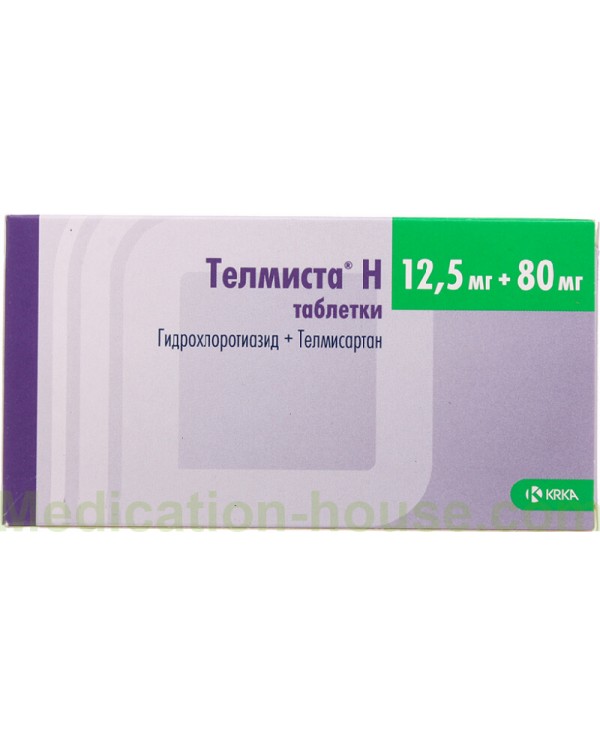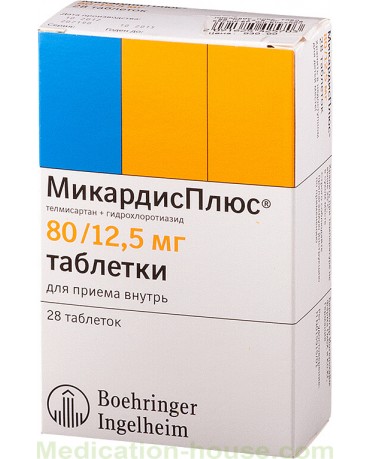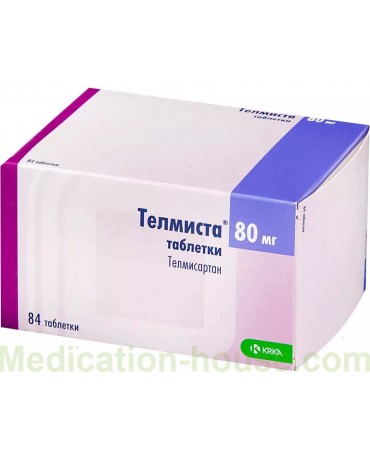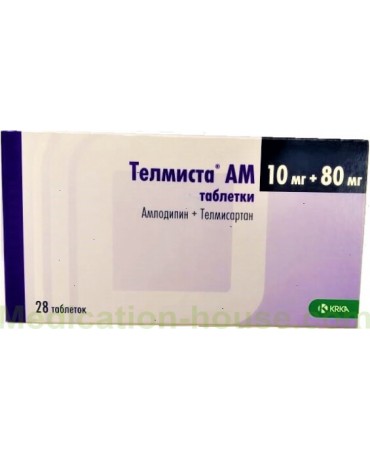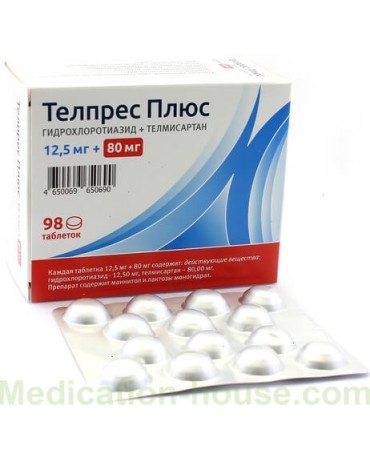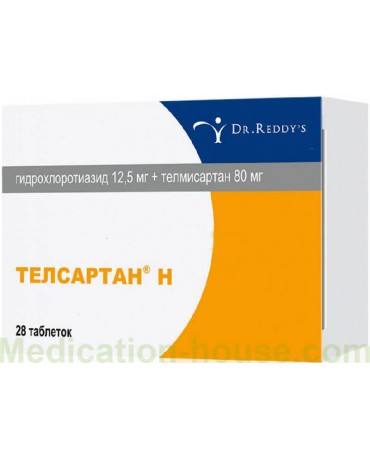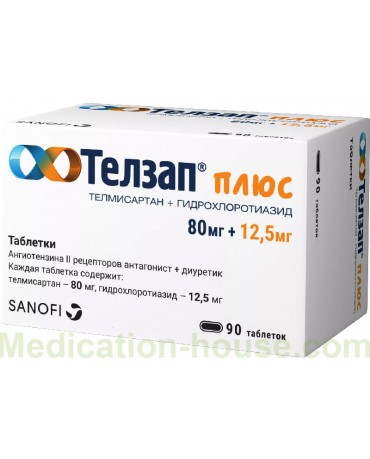Instruction for Telmista H
Reed more and buy Telmista H here
Release form and composition
Pharmaceutical form Telmista H - tablets: biconvex, oval; at a dosage of 12.5 + 40 mg and 12.5 + 80 mg - the outer layer is white or almost white with a pinkish-white tint, the inner layer is pink with light and dark pink blotches; at a dosage of 25 + 80 mg - the outer layer is white or almost white with a yellowish-white tint, the inner layer is yellow with light and dark yellow blotches (7 or 10 pcs. in a blister, in a cardboard pack 2, 4, 8, 12, 14 blisters of 7 pcs. Or 3, 6, 9, 10 blisters of 10 pcs., As well as instructions for the use of Telmista H).
Composition for 1 tablet 12.5 + 40 mg / 12.5 + 80 mg / 25 + 80 mg:
active ingredients: hydrochlorothiazide - 12.5 / 12.5 / 25 mg + telmisartan - 40/80/80 mg;
auxiliary ingredients: sodium hydroxide, meglumine, povidone-K30, sorbitol, lactose monohydrate, magnesium stearate, mannitol, mannitol DC, hyprolose, colloidal silicon dioxide, sodium stearyl fumarate; additionally for tablets with a dosage of 25 + 80 mg - dye iron oxide yellow (E172), for tablets with a dosage of 12.5 + 40 mg and 12.5 + 80 mg - dye iron oxide red (E172).
Pharmacodynamics
Telmista H is a combination of telmisartan (ARA II) and a thiazide diuretic hydrochlorothiazide, the simultaneous use of which provides a more pronounced antihypertensive effect in comparison with the use of each of them in monotherapy.
Telmista N, when taken once a day, makes it possible to gradually significantly reduce blood pressure (BP); the maximum antihypertensive effect is usually achieved 4–8 weeks after the start of treatment.
Telmisartan
Telmisartan is a specific ARA II, effective when taken orally. Shows a high affinity for the AT1-subtype of angiotensin II receptors, the activity of which is realized through these receptors. Displaces angiotensin II from the connection with the receptor, without showing the properties of an agonist in relation to it. Establishes a long-term relationship exclusively with AT1-subtype angiotensin II receptors. Does not express affinity for other angiotensin receptors. Reduces the plasma concentration of aldosterone, does not inhibit renin and does not have a blocking effect on ion channels. Does not inhibit kininase II - ACE (angiotensin-converting enzyme), which destroys bradykinin, and therefore the potentiation of the side effects caused by bradykinin is not expected.
Taking telmisartan at a dose of 80 mg for hypertension completely blocks the increase in blood pressure by angiotensin II. The antihypertensive activity of telmisartan is observed within 3 hours after its first oral administration, the inhibitory effect lasts more than 24 hours, persisting up to 48 hours. A pronounced antihypertensive effect is usually achieved within 4 weeks of regular telmisartan intake. A decrease in systolic and diastolic blood pressure does not affect heart rate (heart rate).
With a sharp cancellation of Telmista H, blood pressure returns to its original values gradually, the withdrawal syndrome is not observed.
A decrease in the incidence of cardiovascular diseases and mortality has been established in patients over 55 years of age with a high risk of cardiovascular pathologies: with coronary artery disease, stroke, peripheral arterial disease or diabetes mellitus with concomitant damage to target organs, for example, retinopathy, left ventricular hypertrophy, history of macro- or microalbuminuria.
Hydrochlorothiazide
The mechanism of action of thiazides is not fully understood. It was found that when taking thiazide diuretics, the blockade of reabsorption of sodium (Na +) and chlorine (Cl−) ions at the beginning of the renal tubules increases their excretion, respectively, accelerating the excretion of water from the body.
Due to the diuretic effect of hydrochlorothiazide, the BCC (circulating blood volume) decreases, which increases the renin activity and the concentration of aldosterone in the plasma, increasing the renal elimination of potassium ions (K +) and reducing the severity of hypokalemia (plasma K + content). In addition, hydrochlorothiazide enhances renal elimination of magnesium ions (Mg2 +) and reduces the excretion of calcium ions (Ca2 +). Thiazides weaken the excretion of uric acid by the kidneys, increasing its concentration in plasma, and reduce the activity of carbonic anhydrase by increasing the excretion of bicarbonate ions, the latter effect is usually weak and does not affect the pH of urine.
At maximum therapeutic doses, all thiazide diuretics exhibit approximately the same diuretic and natriuretic effects. The natriuretic and diuretic effect is manifested within 2 hours; the maximum effect is reached after about 4 hours. The duration of the diuretic activity of hydrochlorothiazide is 6–12 hours.
Hydrochlorothiazide has only an antihypertensive effect and does not affect normal blood pressure.
Pharmacokinetics
Telmisartan and hydrochlorothiazide in Telmista H, when used simultaneously, do not interfere with each other's pharmacokinetics.
Telmisartan
absorption: absorbed quickly, but the amount absorbed may vary. An increase in Cmax (maximum plasma concentration) and, to a lesser extent, AUC (area under the concentration-time curve) is disproportionate to the dose increase. The average absolute bioavailability is ~ 50%. Simultaneous intake with food reduces the AUC from 6 to 19% when taking 40 and 160 mg of telmisartan per day, respectively. 3 hours after taking the drug, the concentration in the blood plasma levels out regardless of the time of the meal;
distribution: there is a high degree of binding with blood plasma proteins (more than 99.5%), mainly with albumin and with α1-acid glycoproteins. Vdss (average volume of distribution in equilibrium state) ~ 500 l;
metabolism: the biotransformation of telmisartan occurs through conjugation of the parent compound with glucuronic acid, with the formation of a conjugate that does not have pharmacological activity;
elimination: T1 / 2 (half-life)> 20 hours. There is no information on clinically significant cumulation of telmisartan when using the recommended doses. It is excreted unchanged through the intestines, renal elimination is less than 2%. L (total clearance) is high, about 1000 ml / min, compared to hepatic blood flow of ~ 1500 ml / min.
Hydrochlorothiazide
absorption: not fully, but rather quickly absorbed from the gastrointestinal tract (gastrointestinal tract). After oral administration at a dose of 100 mg, Cmax in blood plasma is reached after 1.5–2.5 hours. The maximum diuretic activity develops after about 4 hours, Cmax reaches 2 μg / ml;
distribution: binds to plasma proteins by 40%; passes through the placental barrier, is excreted in breast milk, does not penetrate the blood-brain barrier;
metabolism: hydrochlorothiazide is not biotransformed in the human body;
excretion: the primary route is renal elimination unchanged (filtration and secretion). About 61% of the dose taken orally is excreted within 24 hours. With normal renal function, T1 / 2 varies from 5.6 to 14.8 hours. Average T1 / 2 = 6.4 hours.
Indications for use
Telmista H is used for the treatment of arterial hypertension in patients in whom monotherapy with telmisartan or hydrochlorothiazide was ineffective.
Contraindications
Absolute:
obstructive diseases of the bile ducts;
severe hepatic impairment, class C according to the Child-Pugh classification;
severe renal failure with CC (creatinine clearance) <30 ml / min;
hypercalcemia, refractory hypokalemia;
simultaneous reception with aliskiren and aliskiren-containing drugs for diabetes mellitus and / or moderate / severe renal dysfunction [GFR (glomerular filtration rate) <60 ml / min / 1.73 m2];
concomitant use with ACE inhibitors for diabetic nephropathy;
fructose malabsorption, lactose intolerance, lactase deficiency, glucose-galactose malabsorption syndrome;
pregnancy, breastfeeding;
children and adolescents up to 18 years old;
hypersensitivity to the active or auxiliary components of Telmista H, as well as other sulfonamide derivatives.
With caution, Telmista H is prescribed for bilateral renal artery stenosis or stenosis of an artery of a solitary kidney, hepatic dysfunction or progressive liver diseases of classes A and B according to the Child-Pugh classification, a decrease in BCC as a result of previous diuretic use, diarrhea / vomiting, or restriction of salt intake, hyperkalemia, condition after kidney transplant (no experience with use).
Instructions for use: method and dosage
Telmista H tablets are intended for oral administration. They are taken once a day, regardless of the diet.
Telmista H 12.5 + 40 mg is prescribed if monotherapy with telmisartan 40 mg or hydrochlorothiazide does not provide adequate blood pressure control.
Telmista H 12.5 + 80 mg is recommended for use when a daily intake of 80 mg of Telmisartan or Telmista H 12.5 + 40 mg does not provide adequate blood pressure control.
A dosage of 25 + 80 mg is prescribed to patients in whom the intake of 80 mg of telmisartan or Telmista H 12.5 + 80 mg does not provide adequate control of blood pressure, or whose condition was previously stabilized with the separate use of telmisartan or hydrochlorothiazide.
In severe arterial hypertension, taking the maximum daily dose of telmisartan (160 mg) alone or in combination with hydrochlorothiazide (12.5 or 25 mg) is well tolerated and effective.
Side effects
infections and invasions: infrequently - infectious lesions of the upper respiratory tract, urinary tract (including cystitis); rarely - pharyngitis, bronchitis, sinusitis, sepsis, including fatal cases; frequency not established - sialoadenitis;
blood and lymphatic system: infrequently - anemia; rarely - thrombocytopenia, eosinophilia; frequency not established - thrombocytopenia with purpura, aplastic / hemolytic anemia, neutropenia, leukopenia, agranulocytosis;
immune system: rarely - exacerbation or intensification of symptoms of SLE (systemic lupus erythematosus), anaphylaxis, hypersensitivity reactions;
endocrine system: infrequently - hypokalemia, hyperkalemia; rarely - hyponatremia, hyperuricemia, hypoglycemia (in patients with diabetes mellitus); frequency not established - ineffective control of blood glucose levels (violation of tolerance), hypovolemia, electrolyte imbalance, impaired appetite, anorexia, hypercalcemia, hyperglycemia, hypomagnesemia, hypercholesterolemia, hypochloremic alkalosis;
psyche: infrequently - anxiety; rarely - depressive conditions; frequency not established - excitability;
nervous system: infrequently - dizziness, syncope / fainting, paresthesia; rarely - sleep disturbances, insomnia / drowsiness; frequency not established - headache;
organ of vision: rarely - impaired visual perception, transient blurred vision; frequency not established - acute myopia, xanthopsia, acute angle-closure glaucoma;
organ of hearing and labyrinthine disorders: infrequently - vertigo;
heart: infrequently - tachycardia, arrhythmias, bradycardia;
vessels: infrequently - a marked decrease in blood pressure (including orthostatic hypotension); frequency not established - necrotizing vasculitis;
respiratory system, chest and mediastinal organs: infrequently - cough, shortness of breath; rarely - respiratory distress syndrome (including pulmonary edema, pneumonitis); extremely rare - interstitial lung disease;
Gastrointestinal tract: infrequently - diarrhea, dry mouth, flatulence; rarely - dyspepsia, abdominal pain, constipation, vomiting, stomach discomfort, gastritis; frequency not established - nausea, pancreatitis;
liver and biliary tract: rarely - impaired hepatic function; frequency not established - jaundice (hepatocellular, cholestatic);
skin and subcutaneous tissues: rarely - angioedema (up to death), urticaria, erythema, skin rash, pruritus, hyperhidrosis, eczema, drug or toxic skin rash; frequency not established - Lyell's syndrome, lupus-like reactions, cutaneous vasculitis, recurrence of SLE, photosensitivity reaction, erythema multiforme;
musculoskeletal system and connective tissue: infrequently - muscle spasms, back pain, myalgia; rarely - arthralgia, arthrosis, cramps of the calf muscles, pain in the limbs, tendinitis-like symptoms; frequency not established - muscle weakness;
urinary system: infrequently - renal failure, including in acute form; frequency not established - impaired renal function, interstitial nephritis, glucosuria;
genitals and mammary gland: infrequently - erectile dysfunction;
general disorders: infrequently - chest pain, asthenia (weakness); rarely - pain, flu-like symptoms; frequency not established - fever;
data from laboratory and instrumental studies: infrequently - an increase in the content of uric acid in plasma; rarely - an increase in the level of plasma creatinine, an increase in the activity of liver enzymes and creatine phosphokinase, a decrease in the concentration of hemoglobin; frequency not established - hypertriglyceridemia.
Overdose
Symptoms of an overdose of Telmista H are determined by the symptoms of the active components of the drug:
telmisartan: tachycardia, marked decrease in blood pressure, bradycardia;
hydrochlorothiazide: most common - nausea and drowsiness; lowering the BCC; hypokalemia and hypochloremia as a result of a violation of water-electrolyte balance; hypokalemia can cause muscle spasms and / or exacerbate cardiovascular pathologies, for example, arrhythmias that develop as a result of the simultaneous use of cardiac glycosides and certain antiarrhythmic drugs.
There is no specific treatment for Telmista H intoxication. The patient is provided with close medical supervision. Depending on the time elapsed from taking a high dose of the drug, and the severity of symptoms, symptomatic and supportive treatment is carried out, the content of electrolytes in the blood serum and the concentration of creatinine are regularly monitored. With the development of arterial hypotension, the patient is placed on his back and measures are taken to replace electrolytes and restore the BCC.
Telmisartan is not excreted during hemodialysis; the degree of excretion of hydrochlorothiazide has not been established.
Special instructions
With the inhibition of the activity of the RAAS (renin-angiotensin-aldosterone system) in some patients, especially in the case of the simultaneous use of drugs that affect this system, renal failure develops, including in an acute form. Therapy, accompanied by a double blockade of the RAAS (for example, when ACE inhibitors or aliskiren, which is a direct renin inhibitor, to ARA II blockers are added to the regimen), should be carried out strictly individually, accompanied by regular monitoring of renal function, including periodically monitoring the content in serum potassium and creatinine.
In patients with renal insufficiency, thiazide diuretics contribute to the development of azotemia, they are advised to periodically monitor renal function.
With bilateral stenosis of the renal arteries or stenosis of the artery of the only active kidney, drugs that affect the RAAS increase the likelihood of developing severe arterial hypotension, as well as renal failure.
Liver dysfunction or progressive liver disease requires caution when using a combination of hydrochlorothiazide and telmisartan, since even minor changes in water and electrolyte balance can cause hepatic coma.
In some patients, the use of thiazide diuretics causes the development of hyperuricemia and exacerbates the course of gout.
In diabetes mellitus, it may be necessary to adjust the doses of insulin or oral hypoglycemic agents. Taking thiazide diuretics contributes to the manifestation of latent diabetes mellitus.
In patients with diabetes mellitus, the presence of cardiovascular pathologies, such as ischemic heart disease (coronary artery disease), during the use of drugs that lower blood pressure (for example, ARA II or ACE inhibitors), increases the risk of myocardial infarction and sudden cardiac death. With diabetes mellitus, an asymptomatic course of ischemic heart disease and the absence of a diagnosis are possible. Therefore, before starting antihypertensive therapy in order to identify and treat coronary artery disease, it is imperative to conduct appropriate diagnostics, including an exercise test.
Being a sulfonamide derivative, hydrochlorothiazide is capable of causing an idiosyncratic reaction, manifested by acute transient myopia and acute angle-closure glaucoma. Symptoms of these disorders - a sudden decrease in visual acuity or pain in the eyes, as a rule, develop after the start of taking Telmista H for a period from several hours to several weeks. Untreated acute angle-closure glaucoma can cause permanent vision loss. The main therapy is to stop taking hydrochlorothiazide as soon as possible. If intraocular pressure is not controlled, urgent conservative treatment or surgery may be required. Risk factors for acute angle-closure glaucoma are history of hypersensitivity to sulfonamides or penicillin.
Influence on the ability to drive vehicles and complex mechanisms
Taking into account the possibility of dizziness and drowsiness developing during therapy with Telmista H, care must be taken when driving a car or working with complex machinery, machine tools and production equipment.
Application during pregnancy and lactation
The use of Telmista H during pregnancy and lactation is contraindicated.
The study of the effect of the drug on human fertility has not been carried out. In animal studies, the effect of telmisartan and hydrochlorothiazide on fertility has not been established.
Childhood use
Telmista H is not used in pediatrics.
With impaired renal function
No dose adjustment is required in patients with mild or moderate renal impairment; renal function should be monitored during therapy.
In case of severe renal failure with CC <30 ml / min Telmista H is not used.
For violations of liver function
Patients with mild or moderate hepatic impairment of classes A and B according to the Child-Pugh scale Telmista H is prescribed so that the daily dose of hydrochlorothiazide does not exceed 12.5 mg, and telmisartan is 40 mg.
In case of severe liver failure, class C according to the Child-Pugh classification, Telmista H is not prescribed.
Use in the elderly
Correction of the dosage regimen of Telmista H is not required.
Drug interactions
Telmista H contains two active ingredients with high pharmacological activity. The attending physician should determine the clinical significance of their drug interaction with substances / drugs used simultaneously and the possibility of prescribing.
Terms and conditions of storage
Store at temperatures up to 25 ° C in its original packaging (blister pack).
Keep out of the reach of children.
Shelf life is 2 years.
Reviews
According to reviews, Telmista H is an excellent antihypertensive drug, it keeps blood pressure well, in comparison with analogues, it causes a spasmodic cough much less often. The tablets are convenient to take, their cost is often called average by patients, and a large package containing 84 tablets is advantageous.
Terms of sell
You can buy Telmista H without a prescription from a doctor.

